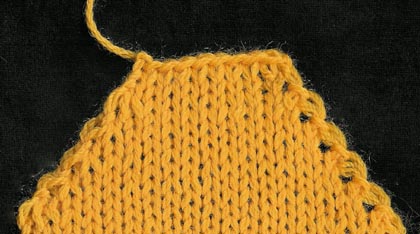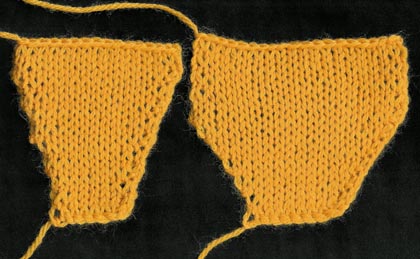11: Shaping
A garment is a balance of texture, shaping, finish and impact.
The first three elements are important to the fourth, but, although
they all lean on each other like a house of cards, shaping is the
keystone that keeps the whole structure together. Shaping is the
difference between a scarf and a piece of clothing.
Your own ideas and knowledge, or those of a pattern writer, will
control the shape of what you knit. The outline of the pieces is
created by increasing or decreasing, casting on and casting off, or
using different sized needles. Then the finished garment is made up
from the shaped pieces joined together. Even if the knitting has
been done with circular needles in one piece, it will be shaped
somewhere.
Shaping is not just structurally important, it is also visually
important. It is the key to easy joining and finishing, and the
matching and placement of shaping is crucial to the way the garment
will look.---
Increasing or decreasing the stitches at the
beginning or end of a row will be correct as far as pattern
instructions are concerned, but shaping in this way creates a
jagged
edge [pic 1,2,3].

1: Decrease edges that result from working shaping on first
two and last two stitches of every knit row. The jagged edge makes
it difficult to work a neat seam.

2: These decreases have been worked on every second knit row,
and the edge is jumbled and bumpy.

3: Left sample increased every second knit row, right sample
increased every knit row. The right edge always looks neater than
the left, but still presents a joining problem.
When you start to pick up stitches along an
edge with bumpy shapings, you will encounter the problem of just
where to place the stitches. You need to be able to see a clearly
defined line of stitches to follow when picking up, both
horizontally and vertically, so that there will be a well shaped
edge. This is crucial if the added knitting is in a contrast colour.
If you have used the edge stitches for shaping, the only place to
pick up stitches will be quite a few stitches in from the edge to
avoid the shaping, which is not ideal. It means that there will be a
thick line behind the pick-up edge.
The perfect (read undetectable) seam requires matching row to row.
If it can be worked one, or at the most, two stitches in from the
edges, there will be less bulk. Knitted fabric drapes and stretches
and fits because it is flexible, and a thick seam doesn’t move as
well as a fine seam. This is difficult to achieve with a bumpy edge,
because shaping stitches really get in the way.
NEXT
PAGE >> chapter
page: 1 | 2 |
3 | 4 | 5
| 6 |